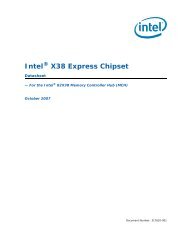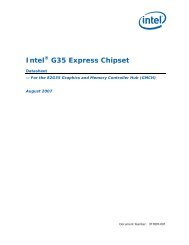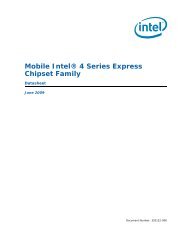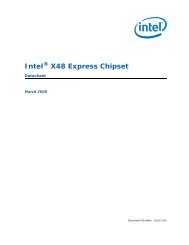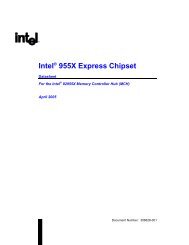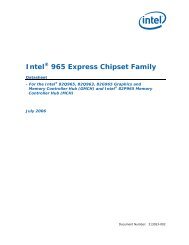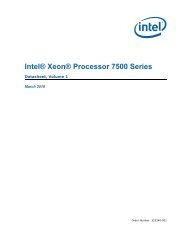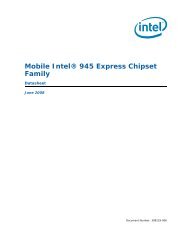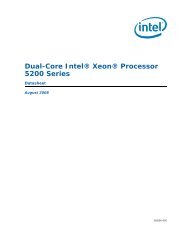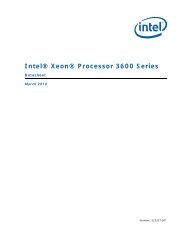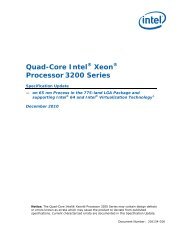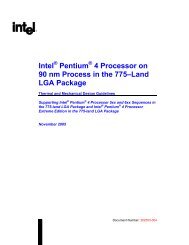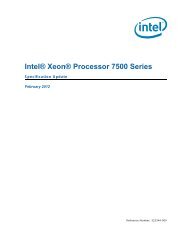Intel® 945G/945GZ/945GC/ 945P/945PL Express Chipset Family ...
Intel® 945G/945GZ/945GC/ 945P/945PL Express Chipset Family ...
Intel® 945G/945GZ/945GC/ 945P/945PL Express Chipset Family ...
You also want an ePaper? Increase the reach of your titles
YUMPU automatically turns print PDFs into web optimized ePapers that Google loves.
3.3 Configuration Mechanisms<br />
Register Description<br />
The processor is the originator of configuration cycles; thus, the FSB is the only interface in the<br />
platform where these mechanisms are used. The MCH translates transactions received through<br />
both configuration mechanisms to the same format.<br />
3.3.1 Standard PCI Configuration Mechanism<br />
The following is the mechanism for translating processor I/O bus cycles to configuration cycles.<br />
The PCI specification defines a slot based "configuration space" that allows each device to<br />
contain up to 8 functions with each function containing up to 256 8-bit configuration registers.<br />
The PCI specification defines two bus cycles to access the PCI configuration space: Configuration<br />
Read and Configuration Write. Memory and I/O spaces are supported directly by the processor.<br />
Configuration space is supported by a mapping mechanism implemented within the (G)MCH.<br />
The configuration access mechanism uses the CONFIG_ADDRESS register (at I/O address<br />
0CF8h though 0CFBh) and CONFIG_DATA register (at I/O address 0CFCh though 0CFFh). To<br />
reference a configuration register, a DWord I/O write cycle is used to place a value into<br />
CONFIG_ADDRESS that specifies the PCI bus, the device on that bus, the function within the<br />
device, and a specific configuration register of the device function being accessed.<br />
CONFIG_ADDRESS[31] must be 1 to enable a configuration cycle. CONFIG_DATA then<br />
becomes a window into the four bytes of configuration space specified by the contents of<br />
CONFIG_ADDRESS. Any read or write to CONFIG_DATA will result in the (G)MCH<br />
translating the CONFIG_ADDRESS into the appropriate configuration cycle.<br />
The (G)MCH is responsible for translating and routing the processor’s I/O accesses to the<br />
CONFIG_ADDRESS and CONFIG_DATA registers to internal (G)MCH configuration registers,<br />
DMI, or PCI <strong>Express</strong>.<br />
3.3.2 PCI <strong>Express</strong>* Enhanced Configuration Mechanism (Intel ®<br />
82<strong>945G</strong>/82<strong>945G</strong>C/82<strong>945P</strong>/82<strong>945P</strong>L (G)MCH Only)<br />
PCI <strong>Express</strong> extends the configuration space to 4096 bytes per device/function as compared to<br />
256 bytes allowed by the PCI Local Bus Specification, Revision 2.3. PCI <strong>Express</strong> configuration<br />
space is divided into a PCI 2.3 compatible region that consists of the first 256B of a logical<br />
device’s configuration space and a PCI <strong>Express</strong> extended region that consists of the remaining<br />
configuration space.<br />
The PCI compatible region can be accessed using either the Standard PCI configuration<br />
mechanism or using the PCI <strong>Express</strong> enhanced configuration mechanism described in this section.<br />
The extended configuration registers may only be accessed using the PCI <strong>Express</strong> enhanced<br />
configuration mechanism. To maintain compatibility with PCI configuration addressing<br />
mechanisms, system software must access the extended configuration space using<br />
32-bit operations (32-bit aligned) only. These 32-bit operations include byte enables allowing<br />
only appropriate bytes within the DWord to be accessed. Locked transactions to the PCI <strong>Express</strong><br />
memory-mapped configuration address space are not supported. All changes made using either<br />
access mechanism are equivalent.<br />
Intel ® 82<strong>945G</strong>/82<strong>945G</strong>/82<strong>945G</strong>C GMCH and 82<strong>945P</strong>/82<strong>945P</strong>L MCH Datasheet 53



